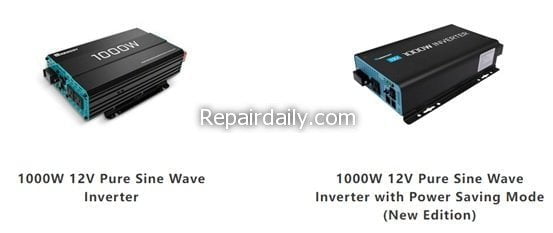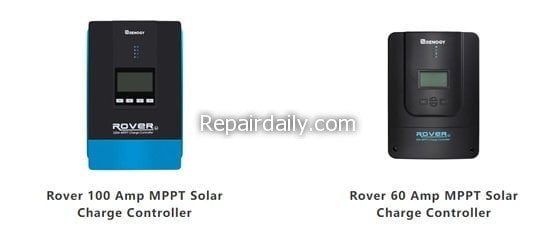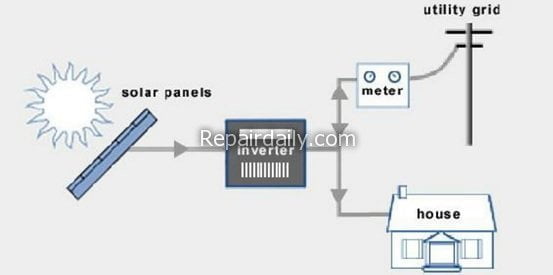

This article examines both the inverter and the charge controller, and seek to make a verdict on which is the better option for you. Both the charge controller and the inverter perform a similar role as they sit between the solar system and the rest of the grid, but they go about their work in markedly different ways.
1. The solar inverter: What is it?
The solar inverters work to convert solar power to 240 volt AC directly. To put it simply, with an inverter, when the sun is shining outside, and the solar panel is picking up its energy, you can use the power produced in your house directly from the panels without having to cycle your batteries. To charge your batteries, you need to pair the battery up with a power inverter that is compatible. This battery-battery inverter pairing is referred to as AC coupling, seeing as the link is with AC electricity in this scheme.
2. The charge controller: what is it?
After solving the problem of solar panels sale, we would get our ideal high-performance solar panels, inverters, batteries, charge controllers and other hardware facilities. The charge controller works to take DC solar power produced from the solar panels and directs it to the batteries for charging. The primary function of the charge controller is to regulate the power that gets to the battery, so as not to overcharge them and risk damaging them. This regulatory function is why some people refer to them as regulators.
The power thus stays in DC format all the way from the solar panels to your batteries. It only goes through 240 volt AC conversion when the time to use it in your house is nigh. This conversion is made possible via the battery inverter we discussed above. This conversion coupling is called DC coupling, seeing as the DC solar panels get coupled with the DC charge controller, with the ultimate goal of charging up the batteries.

3. Where does the difference lie?
The difference is that while the solar inverter is AC coupled, the charge controller is DC coupled.
Which one presents the better option?
There are many reasons as to why anyone would prefer to opt for one and not the other and the argument can be made that it is healthy to have both options in your system.
Here is the thing though- DC coupled systems tend to be more costeffective, and significantly so, for small, domestic standalone systems. AC coupled systems boast of the same cost-effectiveness when it comes to larger systems. If your solar system is small-sized and only powers your house, consider the former. However, if you intend to have a more extensive domestic system, the latter is the better option.
Batteries Without The Solar Panel
Let us take the solar panel away for a bit and focus on the battery itself, minus the panel and incoming charge:
Let us begin at the beginning: a 12 volt battery is… not a 12 volt battery. The 12-volt tag is merely a nominal and convenient term that is used to distinguish one battery type from another. A 12 volt battery that gets fully charged and then allowed to sit or “rest” for several hours, even days, with absolutely no load drawn from it and no charge going into it even out its charge and measures around 12.6 volts between its terminals.
If your battery, under the conditions outlined above, measures a flat 12 volts, then you are the owner of an almost depleted battery that would not serve you very long or very well either. In fact, if the battery resting voltage is at 12.0 or 12.1, the battery only has a maximum of 25% of useful energy remaining. This sort of battery is either almost dead or is intensely recycled to the point where it cannot go through the same treatment again for many more times without getting dead.
Your 12-volt battery supplies useful energy in a particular voltage window: from 14+ volts after you have thoroughly recharged it, down to 10.5 or so volts in use or under load (this is when the TV pictures start to creep toward the center of the screen, and the lights go dim.) Below 10.5 volts, there is not much usefulness in the battery.
No 12-volt battery in the world will be able to stay at 14+ volts for more than a few seconds unless you have hooked it up to the solar panel. Also, while we have said that the useful limit is 10.5 volts, you are merely asking for trouble if you consistently allow your battery levels to fall below 12.5 volts. If the resting voltage reaches 12.1, you have a deep discharged one cycle, and the battery’s life only gets shorter. Here is a tip for you: If you have some friends who have picked up RV experience or especially own RVs, ask them everything you would like to know about battery usage. They are, more often than not, significant resources for battery knowledge seeing as they depend on batteries to watch TV and have light at night.
Water your batteries AFTER charging, unless the plates had been exposed before charging. If the plates are exposed, ensure around 1/8 height of water covers the plates.
Check the water level after charging and ensure that it is ¼ below the fill tube bottom in the cell cover. Moreover, you should not just top up with water from any place: it means a lot to your battery that the water you top it up with is distilled and does not exceed 200TDS (TDS stands for total dissolved solids.)
Sourcing- Shop solar kits
The DIY solar panel kit is appealing as far as costs go. Moreover, in truth, many people have found a lot of success and joy from DIY solar panel kits. However, before you overlook premade solar panels and go full DIY, read this chapter carefully, then make your decision.
What do you get in DIY solar panel kits?
The truth is that it is scarce for a solar panel DIY kit to include all the parts that are necessary for full installation. You will need to make an extra trip to the shop for wires, breakers, conduit fittings, AC/DC disconnects, sub panel and junction boxes. The deficiencies do not stop here: the parts that you find in your kit rarely ever boast of the same efficiency levels as those found in pre-built panels. This book does not mean to slight any regions, but the truth is that the bulk of DIY parts are, in some capacity or other, sourced from China. Make of that what you will. Efficiency levels, it follows, are mediocre and underwhelming. Moreover, if you believe that efficiency is something that you can overlook, think hard: the better the panel efficiency, the more likely it is that your electric bills get lighter. Also, with low-efficiency panels, well, the only way to fight the efficiency problems is to stack as many of them on your roof as is possible. Do you have that much roof at your disposal?
The efficiency issue
Efficiency carries on from the previous chapter. Efficiency will almost always be conveyed as a percentage. By efficiency, we mean the sunlight amount that your panel can convert to electricity. The higher your efficiency is, the higher the watt output. If you use a Costco or Grape Solar DIY panel the efficiency rarely ever cracks 15%, with an output of 235 watts. Calling this underwhelming is an understatement. By comparison, a solar panel pre-built by Renogy has an efficiency of 21%, with a watt output of 345 watts. What this translates to is that for every 22 solar DIY panels, you only need 15 Renogy panels to provide the same wattage. As panels age and take a consistent beating by rain and sun, corrosion eventually sets in. Corrosion affects efficiency levels, and over time, your panels become less productive. Prebuilt panels hold up far better, concerning aging, in comparison to DIY panels.
Upfront solar panel cost versus lifetime value
It is time to consider cost versus value. These days, the dominant solar power companies out there will not only handle shipping issues, but they also provide personnel to install the panels for you. You will have a warranty to prop you up, a superior product on your rooftop and all round assurance that your product will hold up and do so well.
Diy solar system call for you to hire an installer or install it yourself. You may also need to stack more panels on your roof to produce enough electricity. Both of these require money or time. The upfront costs may seem sweet with DIY kits, but the installation costs and maintenance headaches mean that you would not be saving up on much, compared to buying premade panels. It is best to purchase premade panels from reputable companies: you would be grateful for this decision 5 years down the line.
With what we have discussed in mind, let’s now move on to talking about grid tie solar.
Grid Tie Solar
This chapter examines how a grid-tied system works. As far as your solar connection goes, you have the option of either getting hooked up to the grid, in this case having a grid-tied system or going full Kaczynski mode and having it off-grid.
What is a grid-tied system?
There is nothing complicated about this one: this is merely a solar system that is hooked up to the electrical grid. Therefore, you can use electricity from your solar panels as well as that from the electrical grid. If you cannot afford to have as many solar panels as are required to run everything in your home even after doing a usage efficiency evaluation, then having a grid-tied system is ideal. So if anything, winter would not have to bring a scowl on your face, seeing as so many days have little to no sunlight available.

Connecting your house to the grid
For starters, it is necessary to be familiar with all your local interconnection laws. Interconnection laws are those laws that are in place about renewable energy systems, such as solar power systems, and their connection to the electrical grid. To get your system hooked up to the grid, it is necessary to file interconnection applications as well as metering applications.
The benefits that come with a grid-tied system
A grid-tied system gives you several advantages over an off-grid system:
Reliability: Diy off grid solar system is not perfect power systems. There are days when efficiency is reduced, or when the weather is so bad that your electrical appliances may well be running on fumes. An off-grid system is likely to run out of power, leaving you in the dark. This is not so for a grid-tied system. If your solar system is not providing sufficient power, power gets pulled from the electrical grid. The grid is your back up, in case of power failure.
Costs: For you to function at optimal levels, off-grid systems require you to install specialized equipment. This equipment often gets expensive fast. It is also simple math that less equipment means fewer costs directed toward equipment purchase. Such is usually the case with most grid-tied systems. Not only will battery costs not be your concern, but you would not have to deal with such issues as battery maintenance, deep cycle battery(including rv batteries, marine batteries and agm batteries)
Net metering: There would be days when your system produces way more electricity than you could use. With a grid-tied system, you are in a position to feed this excess electricity to the grid. Enter the net metering concept: net metering is a billing system that compensates you for supplying your power to the grid. Since most grid-tied systems are net metered, the power meter then tracks the “power exchanges” between your home and the grid. With excess power production and the feeding of this excess power to the grid, the power meter, rather than spin forward, spins backward. The result is some credit that you can either pocket or use to handle future power-based payments.
Also, if you do not want to go through the headache of paying the utility company, you could go off grid.
